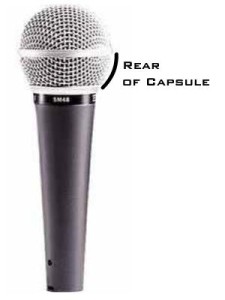Adding an additional set of speakers of the same type to those already in place makes for bad sound. The graphs illustrate what happens when 4 speakers of the same type are covering the same area. Using two speakers gives even coverage for the entire audience (graph right). By making the mistake of adding a second pair, you may create multiple 20db nulls (cancellation of sound) throughout the critical vocal frequencies for a large part of the listening area (graph left), while only experiencing an overall gain of 3dB in volume. That’s not a very good tradeoff! Since EQ cannot correct this (and the attempt will fry some members of the audiences’ ears), the correct approach is simply to increase the volume of your mains by 3dB if you have it, or be content with providing the best possible sound for as much of the audience as possible. And I understand that it doesn’t look as cool.
Not everything goes in the PA. Especially in a small venue where sound levels need to be kept in check, you can use the PA to simply fill in the parts or tones that need a little boosting.
Multiple studies have proven that alcohol consumption affects our hearing by altering how loud different frequencies are percieved. So if your soundman is drinking, be aware that your mix is suffering.
Combining speakers of different types for the same coverage area makes for bad sound. I see bands and venues using different types of mains to cover the same audience area. The result is highs that are fatiguing to the ear and never seem to sit right despite the amount of DSP and EQ applied. To Fix this – Pick the best set of speakers, unplug the other set, and turn your mains up 3db at the mixer and now you have something you can work with…
Many vocalists are aware of how important good mic technique is when performing songs with a wide dynamic range. What some may not know is that improperly holding a mic despite changing the way it sounds, increases the chances of feedback…. Cardioid mics (like the SM58)
are popular for vocals because they have greater sensitivity to the front of the mic (your voice) than sounds coming from the rear of the mic (floor monitors). It is this quality that allows the soundman to turn up the monitor to a volume where the singer can hear themselves without getting feedback. When a singer holds the mic by the capsule or holds it in a way that covers the rear of the capsule, this changes the pic up pattern of the mic from cardioid (rear rejection) to omni directional (equal in all directions) making the mic just as sensitive to the rear as it is to the front. Not only does this change the “sound” of the mic, but it can lead to severe problems with feedback which never sounds good.
We're Serious About Sound


